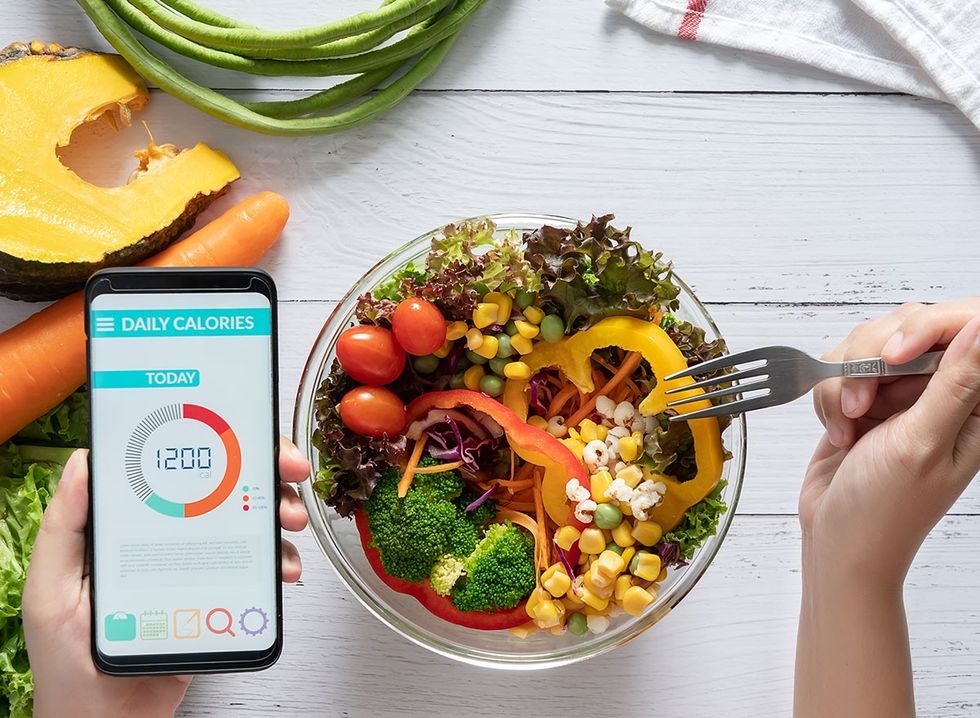Do you want to lose 30 pounds in two weeks? While it might seem impossible, one YouTuber claims it isn’t. Steve Cha of Rockstar Eater, a YouTube channel focusing on his love of food, shared a recent video about how rapidly he lost weight to the tune of a pound every two days. He claims it all boils down to following three simple steps.
He Gained 10 to 12 Pounds After Starting His YouTube Channel
Steve from Rockstar Eater explains that he gained “about 10 to 12 pounds” after starting his YouTube channel from “eating a lot of food” and that “it did take some toll” on his body. He topped the scales at 170, admitting that his blood pressure and cholesterol both went up.
He Gave Himself 30 Days to Lose 15 Pounds
 Shutterstock
Shutterstock
“So I decided that I'm going to take some steps in order to try to take care of my health for the next few weeks. So in this video, I'm gonna be documenting my journey on losing basically 10 to 15 pounds,” he says, giving himself a time frame of 30 days.
His Plan Starts with Exercise
 Shutterstock
Shutterstock
Steve’s plan was to start with exercise. “What I'm gonna do is basically every day do a lot of walking, cardio, jogging in order to sweat, burn some calories,” he says.
It Also Involves Changing His Diet
“And I'm also gonna, of course, alter my diet. That's the most important thing because it's no use for me to go out and do all of this exercising but then come home and snack on all this junk food,” he says. “Of course, I'm not gonna go the drastic route of starving myself, you know, like what some people do. That's actually not healthy at all.”
Protein with Salads or Veggies
 Shutterstock
Shutterstock
What will he be eating for the next few weeks while he’s trying to lose weight? “Definitely low-fat foods,” he says. He might make a big salad and some salmon but only have a third of it, then “probably the other third for dinner. And then for dinner, I can change it up by eating, for example, fish, some cucumber and some baby broccoli, which is really good. I highly recommend this.” He will also eat an apple.
No Fried Food
 Shutterstock
Shutterstock
“So something like this is what I would be eating every day with just some variations, but definitely staying away from all the fried stuff, all the beef, you know, high cholesterol stuff, definitely no ice cream,” he adds.
10,000 Steps Per Day
 Shutterstock
Shutterstock
Steve’s goal is to try to hit about 10,000 steps a day. “On a busy day, I'd probably be walking for about one hour, kind of like a walk-jog. But then, if I have one of those days where it's not that busy, who knows, I might even go for half a day, like three to four hours of walking. But remember, drink plenty of water when you're out here, especially during the summertime,” he says.
Week One He Lost 3 Pounds
 Shutterstock
Shutterstock
“So it's been about a week now, and it looks like I've been able to lose about three pounds in the course of six to seven days. So far off to a good start,” Steve says. “I mean, I'm already feeling it. My body feels a little lighter, and I can get into my pants without feeling so very tight.”
Week Two He Lost Two-and-Half-Pounds
 Shutterstock
Shutterstock
This week I was able to drop about two to two and a half pounds, and I do feel better. Everything feels good all around,” Steve says. If “you're losing weight over time, it gets more difficult and difficult to drop the same amount of weight every single week.”
He Did Cheat
 Shutterstock
Shutterstock
Steve admits that he “did have some cheat days here and there, but for the most part, still sticking to vegetables, fruits, and cereal, oats, you know, all that healthy stuff, and I don't overeat. That's the key. And you gotta also do a lot of exercise.”
30 Day Mark: 15 Pounds
 Shutterstock
Shutterstock
“Moment of truth after 30 days of hard work. Let's see what the final result is.
As many of you guys probably know, that was not an easy task to all of a sudden go onto such a strict diet exercising plan. So yes, it looks like I lost about 14 to 15 pounds in the span of 30 days, which is not easy to do, but it is doable though.”
Step 1: Diet
 Shutterstock
Shutterstock
He then details each step he followed. “Number one, I changed my diet plan,” he reiterates, “eating stuff with less sugar, less sodium, less carbs in it, sticking mainly to fruits and vegetables and oats and wheat. I mean, once in a while, I had my cheat day here and there to eat something heavier, but that's pretty much what I've been sticking to.”
Step 2: Hydrating
 Shutterstock
Shutterstock
The second step? Hydration. “ I've been drinking a lot of water, like a lot of water,” he continues. “No more of the sodas and the fruit juices, mostly water during a lot of these days.”
Step 3: Exercising
 Shutterstock
Shutterstock
His final step? Exercise, including “a lot of cardio, jogging, some stretches here and there,” he says.
It’s Not Easy, But Gets Easier
 Shutterstock
Shutterstock
Steve encourages others to stick to a diet. “It's not easy, I'll tell you that, especially in the first few days. It's gonna be very difficult, but then you kind of get used to it over time,” he says.
His Blood Pressure Decreased
 Shutterstock
Shutterstock
“But overall, I'm definitely feeling it. It's flatter all around my stomach area and my chest and I feel better health-wise. And I was even able to go to the local grocery store to measure my blood pressure. It actually went down by 15, I think I was at 1 35 before in terms of blood pressure. And then I think it went down to about like one 20 or one 17, which is really good.”
So Did His Body Fat
 Shutterstock
Shutterstock
His “body fat level has gone down a little bit as well, and I'm assuming that's also cholesterol,” he notes. “So overall, I'm feeling very healthy. So if you guys want to lose some weight and you want to lose it fast, maybe within 30 days, just letting you know that it is possible.”
The NIH Recommends Losing 1 to 2 Pounds Per Week
 Shutterstock
Shutterstock
Is Steve’s weight loss realistic? According to the National Institutes of Health, no. “Weight loss should be about 1 to 2 pounds per week for a period of 6 months,” they say. That would be a maximum loss of 8 pounds in 30 days.
RELATED: 15 Lazy-Girl Ways to Exercise at Home
Body Network’s Expert Weighs In
 Tara Collingwood
Tara Collingwood
Body Network’s Resident RDN, Tara Collingwood, MS, RDN, CSSD, LD/N, ACSM-CPT, a Board Certified Sports Dietitian and co-author of the Flat Belly Cookbook for Dummies, agrees that starving yourself thin is not a good idea. She notes that rapid weight loss usually leads to weight regain. “Starving and fasting can produce fast weight loss, but it also stresses the body and causes the metabolism to shut down, which in turn can cause rebound weight gain,” she says.
However, sustainable weight loss is possible with the right mindset and approach. "Anything hard takes some discipline, and losing weight is one of the hardest lifestyle habits to modify," says Collingwood. "I coach my clients to think about their motivations for eating to make the changes in their lifestyle that will require them to lose the weight they say they want to lose. With discomfort comes growth and results." she says. And if you enjoyed this article, take advantage of these 15 Quick Ways to Lose Body Fat Percentage in a Week.
💪🔥Body Booster: It's important to have a solid motivation for making tough choices. "When you have a strong reason for making the hard choices, it becomes easier to keep yourself on track," says Collingwood.





















 Shutterstock
Shutterstock Shutterstock
Shutterstock Shutterstock
Shutterstock Shutterstock/siam.pukkato
Shutterstock/siam.pukkato Shutterstock
Shutterstock


 Shutterstock
Shutterstock Shutterstock
Shutterstock Shutterstock
Shutterstock Shutterstock
Shutterstock Shutterstock
Shutterstock Shutterstock
Shutterstock Shutterstock
Shutterstock Shutterstock
Shutterstock Shutterstock
Shutterstock Shutterstock
Shutterstock Shutterstock
Shutterstock Shutterstock
Shutterstock Shutterstock
Shutterstock Shutterstock
Shutterstock Shutterstock
Shutterstock Shutterstock
Shutterstock Tara Collingwood
Tara Collingwood

 I'm a Nutritionist and These 9 High-Protein Snacks Keep My Clients Full While Losing 50 Pounds
I'm a Nutritionist and These 9 High-Protein Snacks Keep My Clients Full While Losing 50 Pounds
 Shutterstock
Shutterstock 2. Processed FoodsShutterstock
2. Processed FoodsShutterstock Shutterstock
Shutterstock Shutterstock/Prostock-studio
Shutterstock/Prostock-studio Shutterstock
Shutterstock Pro TipsShutterstock
Pro TipsShutterstock Shutterstock
Shutterstock Shutterstock
Shutterstock Shutterstock
Shutterstock Shutterstock
Shutterstock Most Women on GLP-1s Are Making a Few Common MistakesShutterstock
Most Women on GLP-1s Are Making a Few Common MistakesShutterstock Soda and Sugary DrinksShutterstock
Soda and Sugary DrinksShutterstock Shutterstock
Shutterstock Eat BreakfastShutterstock
Eat BreakfastShutterstock And Improve Insulin SensitivityShutterstock
And Improve Insulin SensitivityShutterstock Belly Flab Strip Tip: Sugar and Fat Calories Leave Its Mark on Your BodyShutterstock
Belly Flab Strip Tip: Sugar and Fat Calories Leave Its Mark on Your BodyShutterstock Shutterstock
Shutterstock The Drugs Mimic the GLP-1 Hormone Naturally Produced by the BodyShutterstock
The Drugs Mimic the GLP-1 Hormone Naturally Produced by the BodyShutterstock